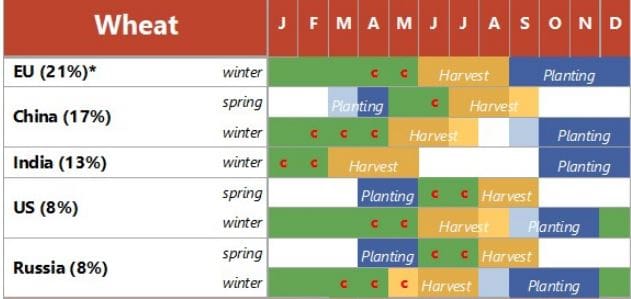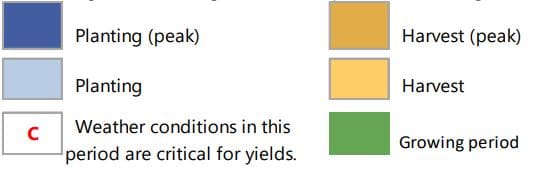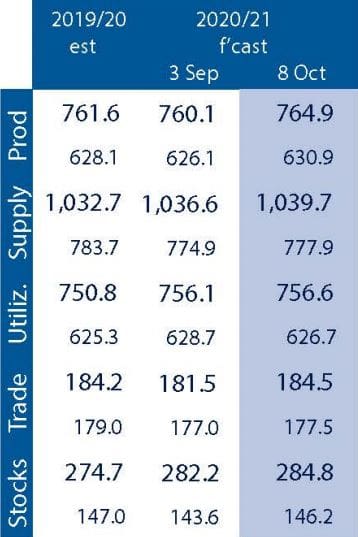World Wheat Crop Heads For New Record
By Paul Homewood
You won’t see this reported by Roger Harrabin!
IMPROVED late-season yield prospects in greater Europe and Australia have lifted the estimate for global wheat production by 5.9 million tonnes (Mt) from the previous Agricultural Market Information Systems (AMIS) estimate released last month.
The lift was offset by a total 1Mt decline in projections in Canada and Argentina.
Table 1. FAO AMIS world wheat projections in million tonnes. Numbers on each second line are world excluding China. Source: FAO AMIS
The net 4.8Mt increase lifts the forecast for the world 2020-21 wheat crop to a record 764.9Mt, pipping by just a few million tonnes the previous records set in 2019-20 and 2017-18 (chart 1).
This month’s upward revisions included Australia and the EU, both up 2.2Mt from last month’s estimate, a 1Mt lift for the Russian Federation, and Ukraine up 500,000t.
Utilisation in 2020-21 is expected to grow at a slightly faster pace than projected earlier, supported by stronger feed use in China.
Conditions mostly favourable
In Argentina, conditions are mixed, with recent rainfall in the south improving conditions. However, in the north and west regions, crop conditions are poor and mostly irreversible due to prolonged dryness throughout the season.

AMIS GEOGLAM crop calendar. Legend below indicates critical phases and activities during the season.
In Australia, conditions are generally favourable except for Queensland which experienced persistent dryness and Western Australia following a dry September.
By contrast, New South Wales is showing exceptional conditions with an expansion of sown area.

In Canada, spring wheat harvest is progressing under favourable conditions with slightly above average yields expected.
In the EU, winter-wheat sowing has begun under generally favourable conditions except for France and Romania where dryness from the summer persists.
In the Russian Federation, spring-wheat harvesting is wrapping up under favourable conditions. Winter-wheat sowing is progressing under dry conditions, particularly in the south, which is hampering emergence and more rainfall is needed before winter dormancy.
In Ukraine, sowing of winter wheat is beginning under mixed conditions due to drought across much of the country, which is delaying sowing for much of the crop.
In the US, sowing of winter wheat is ongoing under favourable conditions.
https://www.graincentral.com/markets/world-wheat-crop-tips-record-amis/
Comments are closed.


It just shows the benefit of having globally distributed food production, it’s highly unlikely, short of a global cataclysmic event, that weather will make for a poor harvest everywhere.
Of course the farming and redistribution would be impossible without fossil fuels.
If people remember the BBC ran a climate scare on the UK wheat harvest a little while back, the latest UK estimate for total tonnage is ~67% of the 5 year average – the worst since 1981, but yields were only on the lower side of normal.
As we ascertained before (with some confusion) the wheat planting season was badly affected by wet, and some land was switched to later planting with Barley, with the result that Barley tonnage was up ~117% of the 5 year average.
It was all irrelevant anyway, because the main point of the BBC article was that this would force up bread/flour prices, but that wheat price is determined by the global market price and UK production is not large enough to be relevant – and in a previous article in a high UK harvest year the BBC said it would not make it cheaper precisely because of that fact!
Yes wheat harvest was down in UK mainly because planting of wheat was down. With record volumes around the world the wheat prices are low so farmers plant more profitable crops. My neighbour who often grows wheat has moved more to barley (all that Gin and beer demand). But even more he is now back with over a thousand pigs on his wheat fields (pork prices firm due to shortages in China). 8yrs ago he had no pigs. 20 years ago he had over 2000 pigs. Market prices determine yields far more than the weather. The lovely market system keeps production and consumption in balance.
However the market balance gets destroyed by spurious regulations. Rape crops are in decline in UK and EU thanks to a ban on neo-nic pesticides, on no evidence of harm but just a hypothesis. Meanwhile global bee population continue to increase because Neo-nics have no influence on them – but you wont hear that on the BBC.
To nitpick!
The UK Wheat/Barley switch this year was mostly weather dictated. You’ll upset our farmer contributors again if you’re not careful.
Weather/pests/disease/crop management determine yields, planting area and yields determine tonnage.
Not reported by Harrabin nor the DT nor theTimes , nor the Mail nor any other MSM who have already got an established view on crop yields.
You can’t expect them to report every single mishap.
What’s the point of fussing about forecasts? Why not wait until the numbers are firm?
dearieme,
Farmers, agribusiness, and governments make plans based on forecasts.
Examples:
– Farmer: Should I sell my stored wheat this week, or wait a month?
– Business: Should we buy now, or is the price going down; and what does that do for our competitiveness in the boxed cereal aisle?
– Business: If farmers are making lots of money they will buy new tractors; we need to order steel.
– Governments: a few cents per kilogram can impact the well being of importers budgets – see . . .
Top 10 importers
Go here to read about how these things happen:
Futures contracts
Please be kind.
They need some time to figure out the downside of this.
Surely there must be a downside, no?
Climate change by definition has downsides.
That’s the science of it anyway.
Pls see
https://tambonthongchai.com/2018/08/03/confirmationbias/
This good news is bound to give the global warming crowd the heebie-jeebies.
I follow an Iowa farm family on YouTube. They grow soybeans and corn on a large scale. This summer they were hit by drought and then the derecho which went across parts of the Midwest. Some of their corn was bent and some was flattened. They are now harvesting the corn and using modifications to their equipment which allows the harvester to pick up the downed corn. It has affected their yield. The 2 young sons can run all of the planting, spraying and harvesting equipment. The older (Cole: 23 and graduated from Iowa State) does a lot of the business end of the operation, while the other (Cooper), still in high school, does a lot of the major repairs including welding. As they say, you cannot control the weather, just how you react to it. They certainly roll with the punches gracefully.
O/T EDFenergy advert that promotes magic battery storage solutions
Funny that <a href="https://twitter.com/edfenergy/status/1318235677058867204 the image is actually a stock photo
of “Server racks in server room data center”
https://stock.adobe.com/uk/images/server-racks-in-server-room-data-center/123123866
EDF have now deleted that advertising tweet
which falsely showed a data centre to represent a battery storage project
Crop growth is primarily determined by the amount of sunlight (solar radiation) that the crop can intercept and use during its life. Too much radiation is rarely a problem as long as water and nutrients are in adequate supply……….. Crop growth rate increases linearly with absorbed sunlight.
http://wheatdoctor.org/sunlight-effects
————————————–
“You won’t see this reported by Roger Harrabin!”
Wanna bet. WHEAT CROPS HIT DUE TO CLIMATE CHANGE.
About the drought in Argentina. “However, in the north and west regions, crop conditions are poor and mostly irreversible due to prolonged dryness throughout the season.”
“Queensland which experienced persistent dryness and Western Australia following a dry September.”
We are all going to die.
On a more serious note, these increases, if they are because of more CO2 and warmer climates, are vulnerable if we head in to a new minimum
As a resident of the USA – where food is abundant – we have a multitude of choices. Bread is no exception. The experience related in the blog below has happened to visitors we know of:
Bread follows milk:
https://thatswhatshehad.com/what-surprised-me-in-america/
Reblogged this on Odyssey and commented:
Reposted from Paul Homewood’s site “Not a Lot of People Know That”. And they don’t. Did you? Record harvests – is this the climate disaster we are told to fear? “The only thing to fear is fear itself” said Franklin D. Roosvelt. More CO2 makes more photosynthesis. Primary school level science that contradicts the whole army of salaried climate doomsayers. Or as Michael Stipe of REM would put it, “It’s the end of the world as we know it and I feel fine!”
Even more food could be produced if they weren’t converting some of the output into biofuels.